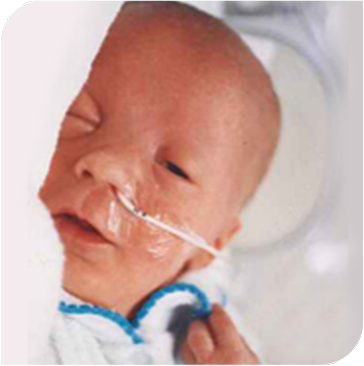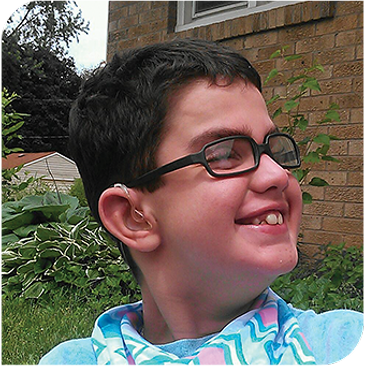Behind every PBD-ZSD is peroxisomal dysfunction2
Peroxisomes are important organelles found throughout the body and involved in many catabolic and anabolic metabolic pathways.2 Functional peroxisomes are necessary for multiple key functions:
Conversion of dihydroxycholestanoic acid (DHCA) and trihydroxycholestanoic acid (THCA) into cholic acid3
Metabolism of very long–chain fatty acids (VLCFAs)1,4
Degradation of VLCFAs2
The classification and phenotype of PBD‑ZSD can vary1
PBD‑ZSD has been historically described as 3 distinct diseases, but guidelines recommend classification based on the spectrum of disease.2,5-7
Severe
(formerly Zellweger syndrome)
Intermediate
(formerly neonatal adrenoleukodystrophy)
Less severe
(formerly infantile Refsum disease)
Depending on severity and progression, survival ranges from <1 year up to adulthood.2
Photos of ZSD patients.
ZELLWEGER SPECTRUM2,5-7

NEONATAL-INFANTILE
Zellweger syndrome
Severe hypotonia
Failure to thrive
Hepatomegaly
Hepatic dysfunction (jaundice)
Craniofacial dysmorphism
Coagulopathy
Sensorineural hearing loss
Ocular abnormalities
Enamel abnormalities
PEDIATRIC
Neonatal adrenoleukodystrophy
Mild hypotonia
Failure to thrive
Hepatomegaly
Hepatic dysfunction
Craniofacial dysmorphism
Coagulopathy
Sensorineural hearing loss
Ocular abnormalities
Enamel abnormalities
Leukodystrophy
Developmental delay
Adrenal insufficiency
ADOLESCENT-ADULT
Infantile Refsum disease
Developmental delay
Peripheral neuropathy
Cerebellar ataxia
Leukodystrophy
Adrenal insufficiency
Sensorineural hearing loss
Ocular abnormalities
Enamel abnormalities
Clinical presentation
In affected patients, the severity and range of signs and symptoms vary according to subgroup, based on age at presentation. Signs and symptoms also can vary by patient within severity subgroups, ie, not every patient will present the same way, even if they are grouped as all severe, all moderate, or all mild.1,2
Patients with milder signs and symptoms may have a delay in diagnosis, as these signs and symptoms may not appear abnormal to parents. In addition, many other diseases present similarly. Overall, common presenting signs include developmental delay and other neurologic abnormalities, vision impairment (due to retinal degeneration), sensorineural hearing loss, and evidence of liver disease.2,8
Identifying liver involvement
Nutrition
- Clinical assessment uncovers nutritional issues, including steatorrhea and failure to thrive1,9
- Failure to thrive is defined as either a weight for age that falls below the fifth percentile on multiple occasions or a weight deceleration that crosses 2 major percentile lines on a growth chart10
- Depleted pool of primary bile acids in PBD‑ZSD can lead to poor absorption of fats and fat-soluble vitamins, and poor growth1,3
Liver function tests
- Elevated liver function tests (LFTs) (alanine aminotransferase [ALT], aspartate aminotransferase [AST], and bilirubin)1:
- Elevated ALT is strongly associated with a higher risk of all-cause and liver-associated mortality11,12
- Verify the absence or presence of hepatotoxic atypical bile acids2
Atypical bile acids
- Accumulation of atypical bile acids (DHCA/THCA)4:
- Testing for the presence of DHCA and THCA is a sensitive and accurate way to detect early or subclinical liver involvement in patients with PBD‑ZSD4
- Accumulation of DHCA and THCA is associated with liver involvement and disease progression2-4
Once liver involvement is detected, appropriate care and treatment options should be initiated as early as possible.1,13
INDICATIONS AND LIMITATIONS OF USE
CHOLBAM® (cholic acid) is a bile acid indicated for
•
Treatment of bile acid synthesis disorders due to single enzyme defects.
•
Adjunctive treatment of peroxisomal disorders, including Zellweger spectrum disorders, in patients who exhibit manifestations of liver disease, steatorrhea, or complications from decreased fat-soluble vitamin absorption.
LIMITATIONS OF USE
The safety and effectiveness of CHOLBAM on extrahepatic manifestations of bile acid synthesis disorders due to single enzyme defects or peroxisomal disorders, including Zellweger spectrum disorders, have not been established.
IMPORTANT SAFETY INFORMATION
WARNINGS AND PRECAUTIONS – Exacerbation of liver impairment
•
Monitor liver function and discontinue CHOLBAM in patients who develop worsening of liver function while on treatment.
•
Concurrent elevations of serum gamma glutamyltransferase (GGT) and alanine aminotransferase (ALT) may indicate CHOLBAM overdose.
•
Discontinue treatment with CHOLBAM at any time if there are clinical or laboratory indicators of worsening liver function or cholestasis.
ADVERSE REACTIONS
•
The most common adverse reactions (≥1%) are diarrhea, reflux esophagitis, malaise, jaundice, skin lesion, nausea, abdominal pain, intestinal polyp, urinary tract infection, and peripheral neuropathy.
DRUG INTERACTIONS
•
Inhibitors of Bile Acid Transporters: Avoid concomitant use of inhibitors of the bile salt efflux pump (BSEP) such as cyclosporine. Concomitant medications that inhibit canalicular membrane bile acid transporters such as the BSEP may exacerbate accumulation of conjugated bile salts in the liver and result in clinical symptoms. If concomitant use is deemed necessary, monitoring of serum transaminases and bilirubin is recommended.
•
Bile Acid Binding Resins: Bile acid binding resins such as cholestyramine, colestipol, or colesevelam adsorb and reduce bile acid absorption and may reduce the efficacy of CHOLBAM. Take CHOLBAM at least 1 hour before or 4 to 6 hours (or at as great an interval as possible) after a bile acid binding resin.
•
Aluminum-based Antacids: Aluminum-based antacids have been shown to adsorb bile acids in vitro and can reduce the bioavailability of CHOLBAM. Take CHOLBAM at least 1 hour before or 4 to 6 hours (or at as great an interval as possible) after an aluminum-based antacid.
PREGNANCY
No studies in pregnant women or animal reproduction studies have been conducted with CHOLBAM.
LACTATION
Endogenous cholic acid is present in human milk. Clinical lactation studies have not been conducted to assess the presence of CHOLBAM in human milk, the effects of CHOLBAM on the breastfed infant, or the effects of CHOLBAM on milk production. The developmental and health benefits of breastfeeding should be considered along with the mother’s clinical need for CHOLBAM and any potential adverse effects on the breastfed infant from CHOLBAM or from the underlying maternal condition.
GERIATRIC USE
It is not known if elderly patients respond differently from younger patients.
HEPATIC IMPAIRMENT
•
Discontinue treatment with CHOLBAM if liver function does not improve within 3 months of the start of treatment.
•
Discontinue treatment with CHOLBAM at any time if there are clinical or laboratory indicators of worsening liver function or cholestasis. Continue to monitor laboratory parameters of liver function and consider restarting at a lower dose when the parameters return to baseline.
OVERDOSAGE
Concurrent elevations of serum GGT and serum ALT may indicate CHOLBAM overdose. In the event of overdose, the patient should be monitored and treated symptomatically. Continue to monitor laboratory parameters of liver function and consider restarting at a lower dose when the parameters return to baseline.
Please see full Prescribing Information for additional Important Safety Information.
References: 1. Braverman NE, Raymond GV, Rizzo WB, et al. Peroxisome biogenesis disorders in the Zellweger spectrum: an overview of current diagnosis, clinical manifestations, and treatment guidelines. Mol Genet Metab. 2016;117(3):313-321.doi:10.1016/j.ymgme.2015.12.009 2. Klouwer FCC, Berendse K, Ferdinandusse S, Wanders RJA, Engelen M, Poll-The BT. Zellweger spectrum disorders: clinical overview and management approach. Orphanet J Rare Dis. 2015;10:151. doi:10.1186/s13023-015-0368-9 3. Baes M, Van Veldhoven PP. Hepatic dysfunction in peroxisomal disorders. Biochim Biophys Acta. 2016;1863(5):956-970. doi:10.1016/j.bbamcr.2015.09.035 4. Zeynelabidin S, Klouwer FCC, Meijers JCM, et al. Coagulopathy in Zellweger spectrum disorders: a role for vitamin K. J Inherit Metab Dis. 2018;41(2):249-255. doi:10.1007/s10545-017-0113-8 5. Braverman NE, D' Agostino MD, MacLean GE. Peroxisome biogenesis disorders: biological, clinical and pathophysiological perspectives. Dev Disabil Res Rev. 2013;17(3):187-196. doi:10.1002/ddrr.1113 6. Zellweger H, Maertens P, Superneau D, Wertelecki W. History of the cerebrohepatorenal syndrome of Zellweger and other peroxisomal disorders. South Med J. 1988;81(3):357-364. doi:10.1097/00007611-198803000-00017 7. Poll-The BT, Saudubray JM, Ogier HAM, et al. Infantile Refsum disease: an inherited peroxisomal disorder: comparison with Zellweger syndrome and neonatal adrenoleukodystrophy. Eur J Pediatr. 1987;146(5):477-483. doi:10.1007/BF00441598 8. Baumgartner MR, Poll-The BT, Verhoeven NM, et al. Clinical approach to inherited peroxisomal disorders: a series of 27 patients. Ann Neurol. 1998;44(5):720-730. doi:10.1002/ana.410440505 9. Berendse K, Klouwer FCC, Koot BGP, et al. Cholic acid therapy in Zellweger spectrum disorders. J Inherit Metab Dis. 2016;39(6):859-868. doi:10.1007/s10545-016-9962-9 10. Homan GJ. Failure to thrive: a practical guide. Am Fam Physician. 2016;94(4):295-300. 11. Kim WR, Flamm SL, Di Bisceglie AM, Bodenheimer HC Jr; on behalf of the Public Policy Committee of the American Association for the Study of Liver Disease. Serum activity of alanine aminotransferase (ALT) as an indicator of health and disease. Hepatology. 2008;47(4):1363-1370. doi:10.1002/hep.22109 12. Kunutsor SK, Apekey TA, Seddoh D, Walley J. Liver enzymes and risk of all-cause mortality in general populations: a systematic review and meta-analysis. Int J Epidemiol. 2014;43(1):187-201. doi:10.1093/ije/dyt192 13. Setchell KDR, Balistreri WF, Piccoli DA, Clerici C. Oral bile acid therapy in the treatment of inborn errors in bile acid synthesis associated with liver disease. In: Paumgarlner G, Stiehl A, Gerok W, eds. Bile Acids as Therapeutic Agents: From Basic Science to Clinical Practice: Proceedings of the 58th Falk Symposium. Kluwer;1991:367-373.







